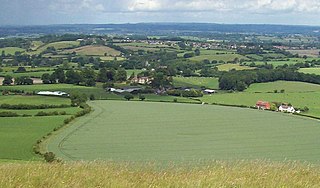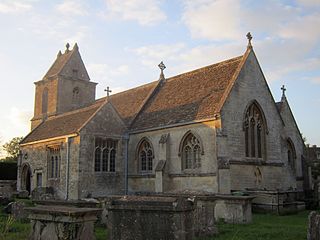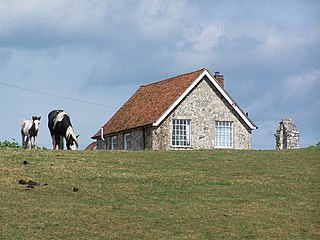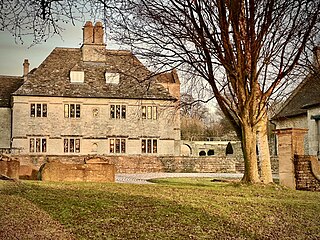
Monkton House in Broughton Gifford, Wiltshire, England is a Grade II* listed 16th-century house. [1]

Monkton House in Broughton Gifford, Wiltshire, England is a Grade II* listed 16th-century house. [1]
In the 12th century Cluniac monks of the Order of Saint Benedict founded a monastery at Monkton Farleigh, acquiring land in the neighbourhood. On the Dissolution of the Monasteries the priory and abbey land, including the manor of Monkton, were given to Sir Edward Seymour, 1st Earl of Hertford. Seymour leased it in 1600 to Edward Long, [2] son of a wealthy Wiltshire clothier, Henry Long of Whaddon. Edward had already purchased the manor of Rood Ashton three years before.
Long later bought the house on 15 May 1615 and left it to his two sons Edward and John, who occupied it in succession. John appears to have carried out an extensive building programme in or around 1647 (marked by a plaque on the wall of the house) involving repairs, alterations, re-roofing and an extension on the eastern side. A chimney-piece with heavy carving, believed to be part of an altar tomb from Monkton Farleigh Priory is in one of the bedrooms.
At some point during the English Civil War the household was forced to accommodate soldiers fighting for Cromwell's Parliamentarian army. Possibly John's building programme stretched his finances as he was labelled a delinquent (1649–50) and his estate was sequestered. He was succeeded by his son Thomas Long of Rowden in Chippenham (died 1691), the estate was secured, and continued in the Long family until 10 May 1669 when Thomas sold it to Sir James Thynne of Longleat. However, Thomas appears to have continued to rent the property until 1671. William Thynne then appears as the owner. [3]
The house is currently owned by the Kirk family.

Broughton Gifford is a village and civil parish about 1.5 miles (2.4 km) west of Melksham in Wiltshire, England. The parish includes the hamlets of Norrington Common and The Common.

Edward Seymour, 8th Duke of Somerset was an English peer and landowner.

Monkton Farleigh is a village and civil parish in west Wiltshire, England, on high ground 3 miles (5 km) northwest of Bradford-on-Avon, and a similar distance east of the city of Bath. The parish includes the hamlets of Farleigh Wick and Pinckney Green. In the west and northwest the parish is bounded by Somerset.

Corsley is a hamlet and civil parish 3 miles (5 km) west of Warminster in Wiltshire, England. The parish is on the county border with Somerset; the Somerset town of Frome is about 3 miles (5 km) to the northwest. The largest settlement in the parish is Corsley Heath, which is on the A362 Warminster-Frome road.

Horningsham is a small village and civil parish in Wiltshire, England, on the county border with Somerset. The village lies about 4 miles (6 km) southwest of the town of Warminster and 4+1⁄2 miles (7 km) southeast of Frome, Somerset.

This is a list of the sheriffs and high sheriffs of Wiltshire.

South Wraxall Manor is a Grade I listed country house which dates from the early 15th century, at South Wraxall in the English county of Wiltshire, about 3 miles (5 km) north of Bradford on Avon. According to popular legend, the house was the first place tobacco was smoked in England, by Sir Walter Long and his friend Sir Walter Raleigh.
Amesbury Abbey was a Benedictine abbey of women at Amesbury in Wiltshire, England, founded by Queen Ælfthryth in about the year 979 on what may have been the site of an earlier monastery. The abbey was dissolved in 1177 by Henry II, who founded in its place a house of the Order of Fontevraud, known as Amesbury Priory.
Sir Walter Long was an English knight and landowner, born in Wiltshire, the son of Sir Robert Long and his wife Barbara Carne.

Monkton Farleigh Manor is a Grade I listed country house close to the village of Monkton Farleigh in Wiltshire, England. Built on the site of a Cluniac priory founded in 1125, the house is about 3 miles (5 km) northwest of Bradford-on-Avon and 4 miles (6 km) east of the city of Bath.

Sir John Thynne was the steward to Edward Seymour, 1st Duke of Somerset, and a member of parliament. He was the builder of Longleat House, and his descendants became Marquesses of Bath.

South Wraxall is a village and a civil parish in Wiltshire, England, 2.5 miles (4.0 km) north of Bradford on Avon. The village is to the east of the B3109 road from Bradford on Avon to Corsham.
Wulfhall or Wolfhall is an early 17th-century manor house in Burbage parish, Wiltshire, England. It is north-east of Burbage village, and about 5 miles (8 km) south-east of Marlborough. A previous manor house on the same site, at that time in the parish of Great Bedwyn, was the seat of the Seymour family, a member of which, Jane Seymour, was queen to King Henry VIII.

Monkton Deverill is a village and former civil parish in Wiltshire, England, about five miles south of Warminster and four miles north-east of Mere. The area has been part of Kingston Deverill parish since 1938. It lies on the River Wylye and forms part of a group of villages known as the Upper Deverills.

Longleat Priory was a priory near Warminster, Wiltshire, in the south of England. A short-lived priory was established and dissolved near to Longleat in the 12th century. The main priory was established before 1233 and was under the control of the Dean of Salisbury until its dissolution in 1529.
The Priory of St Mary Magdalene was a Cluniac priory in Monkton Farleigh, Wiltshire, England, in the 12th to 16th centuries.
John Edward Jackson was an English clergyman of the Church of England, antiquary, and archivist.
Mary Seymour, Duchess of Somerset, formerly Mary Webb, was the wife of Edward Seymour, 8th Duke of Somerset, and the mother of both the 9th and 10th dukes.

Rudloe Manor is a 17th-century Grade II* listed manor house in Box parish, Wiltshire, England.